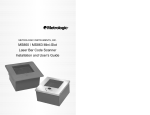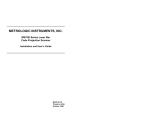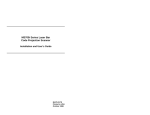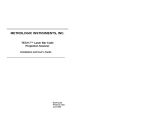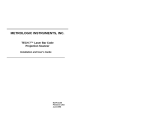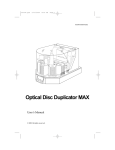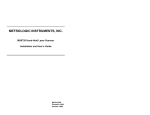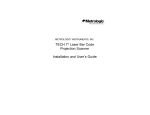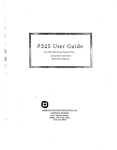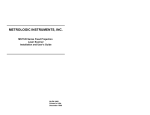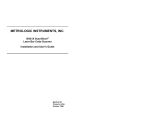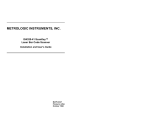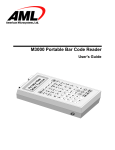Download Metrologic MS860i User`s guide
Transcript
METROLOGIC INSTRUMENTS, INC. MS860i Mini-Slot™ Laser Bar Code Scanner Installation and User’s Guide MLPN 2202 Printed in USA January 1999 Locations: USA Corporate Headquarters Metrologic Instruments, Inc. 90 Coles Road Blackwood, NJ 08012 Customer Service: 1-800-ID-METRO Tel: 609-228-8100 Fax: 609-228-6673 [email protected] www.metrologic.com Europe Metrologic Instruments GmbH Dornierstrasse 2 82178 Puchheim b. Munich, Germany Tel: 49-89-89019-0 Fax: 49-89-89019-200 [email protected] ASIA Metrologic Asia (PTE) Ltd. 31, Kaki Bukit Road 3 #05-08 Techlink Singapore 417818 Tel: 65-842-7155 South America Metrologic Instruments Rua Flórida, 1.821-5°Andar-Brooklin CEP 04571-090, São Paulo-SP, Brasil Outside Brazil: Tel: 55-11-5505-6568 ii Table of Contents Introduction . . . . . . . . . . . . . . . . . . . . . . . . . . . . . . . . . . . . . . . . . . . . . . . . . . 1 Unpacking List . . . . . . . . . . . . . . . . . . . . . . . . . . . . . . . . . . . . . . . . . . . . . . . . . 2 Scanner Connections to the Host . . . . . . . . . . . . . . . . . . . . . . . . . . . . . . . . . . . 3 Configuration of the Scanner to the Host System . . . . . . . . . . . . . . . . . . . . . . 4 Cloning Feature . . . . . . . . . . . . . . . . . . . . . . . . . . . . . . . . . . . . . . . . . . . . . . . . 5 Version 11 IBM 46XX Scanner . . . . . . . . . . . . . . . . . . . . . . . . . . . . . . . . . . . Configuring the MS860i-11 Scanner . . . . . . . . . . . . . . . . . . . . . . . . Configuring the IBM 46XX . . . . . . . . . . . . . . . . . . . . . . . . . . . . . . . IBM 4683 and 4693 Terminals Driven by a 46XX Store Controller Running 4680.OS or 4690.OS . . . . . . . . . . . . IBM 4684 and 4694 Systems . . . . . . . . . . . . . . . . . . . . . . . . . . . . . . 6 7 8 8 8 Version 17 Keyboard Wedge Scanner . . . . . . . . . . . . . . . . . . . . . . . . . . . . . . 9 Connection of a MS860i-17 Scanner to a PC . . . . . . . . . . . . . . . . . . . . . . . . 10 Installing the Scanner into a Counter . . . . . . . . . . . . . . . . . . . . . . . . . . . . . . 11 Attaching the Vertical Stand to the Work Surface . . . . . . . . . . . . . . . . . . . . 12 MS860i Features . . . . . . . . . . . . . . . . . . . . . . . . . . . . . . . . . . . . . . . . . . . . . . 13 Touch Plate . . . . . . . . . . . . . . . . . . . . . . . . . . . . . . . . . . . . . . . . . . . . . . . 14, 15 Visual Indicators . . . . . . . . . . . . . . . . . . . . . . . . . . . . . . . . . . . . . . . . . . . 16-19 Volume Settings . . . . . . . . . . . . . . . . . . . . . . . . . . . . . . . . . . . . . . . . . . . . . . . 20 Labels . . . . . . . . . . . . . . . . . . . . . . . . . . . . . . . . . . . . . . . . . . . . . . . . . . . . . . 21 Depth of Field . . . . . . . . . . . . . . . . . . . . . . . . . . . . . . . . . . . . . . . . . . . . . . . . 22 Depth of Field and Symbol Specification . . . . . . . . . . . . . . . . . . . . . . . . 23, 24 iii Maintenance . . . . . . . . . . . . . . . . . . . . . . . . . . . . . . . . . . . . . . . . . . . . . . . . . . 25 Applications and Protocols . . . . . . . . . . . . . . . . . . . . . . . . . . . . . . . . . . . . . 25 Appendix A Specifications . . . . . . . . . . . . . . . . . . . . . . . . . . . . . . . . . . . . . . 26, 27 Appendix B Default Settings . . . . . . . . . . . . . . . . . . . . . . . . . . . . . . . . . . . . . 28-35 Appendix C Pin Assignments . . . . . . . . . . . . . . . . . . . . . . . . . . . . . . . . . . . . 36-41 Appendix D Warranty and Disclaimer . . . . . . . . . . . . . . . . . . . . . . . . . . . . . 42, 43 Appendix E Notices . . . . . . . . . . . . . . . . . . . . . . . . . . . . . . . . . . . . . . . . . . . 44, 45 Appendix F Patents . . . . . . . . . . . . . . . . . . . . . . . . . . . . . . . . . . . . . . . . . . . . . . . 46 Volume Control Card . . . . . . . . . . . . . . . . . . . . . . . . . . . . . . . . . . . . . . . 47, 48 Index . . . . . . . . . . . . . . . . . . . . . . . . . . . . . . . . . . . . . . . . . . . . . . . . . . . . 49, 50 iv Introduction Metrologic's MS860i Mini-Slot™ Laser Bar Code Scanner is a high-speed, aggressive in-counter scanner. The MS860i unsurpassed scanning accuracy and incorporates the most advanced laser technology in a smaller, yet rugged and durable housing. Designed to be used where counter space is at a premium, the MS860i can be used in a variety of applications. The MS860i autodiscriminates all standard bar codes, eliminating the need to "key in" unprogrammed codes increasing productivity and efficiency. A code correcting feature (MECCA)© enables the MS860i to decode damaged or truncated codes on the first pass, making the MS860i an excellent choice for reclamation and coupon redemption applications. Each version of the MS860i provides three interface options, with full RS-232 protocol available on every scanner. Three most popular protocols (RS-232, OCIA and Light Pen Emulation) are consolidated into the standard model. For simple PC connectivity, a keyboard wedge interface is also available. Metrologic also offers a patented Hand-Held Option, which allows users to connect the MS941 Hand-Held Scanner to the MS860i for greater scanning versatility. The MS860i is easy to program via bar code menus from ScanSelect™ Scanner Programming Guide or by using Metrologic's ScanSet™ IBM® compatible software program. Other key features of the MS860i are the auto-off/touch-on plate and easily visible LED indicators mounted on the brushed stainless steel top plate. An optional hardened glass window is also available. Universal adaptor plates make it simple to replace older, larger flatbed scanners with the smaller MS860i. Metrologic also provides a vertical mounting option, so customers can use the MS860i as a projection scanner as well. Most importantly, the MS860i is easy to afford. It offers a superior, versatile and low cost alternative to larger, more expensive in-counter scanners. 1 Unpacking List The shipping carton contains the following: ! Installation and User’s Guide (MLPN: 2202) ScanSelect™ Scanner Programming Guide (MLPN: 2186) Volume Control Card (MLPN: 2346) ! MS860i Laser Bar Code Projection Scanner ! Installation Plate (MLPN: 45471) ! Power Supply (optional) ! Communication cable with connection for power supply (optional) or Communication Cable (optional) ! Adaptor Plate or Vertical Stand (optional) If any item is missing or to order additional items, contact the dealer, distributor or call Metrologic’s Customer Service Department at 1-800-ID-METRO or 1800-436-3876. 2 Scanner Connections to the Host To maintain compliance with applicable standards, all circuits connected to the scanner must meet the requirements for SELV (Safety Extra Low Voltage) according to EN 60950. To avoid potential problems, do not power up the scanner until the communication cable is secured to the host. 1. Turn off the host system. 2. Connect the 25-pin D-type connector on the scanner’s head cable to the communication cable. Connect the other end of the communication cable to the host device. (If the scanner will not receive power from a transformer, skip to Step 5.) 3. If the scanner will receive power from an external power source, check the AC input requirements of the transformer to make sure the voltage matches the AC outlet. (A socket-outlet shall be installed near the equipment and shall be easily accessible.) 4. Plug the transformer into the side of the female D-type connector located on the communication cable. Plug the transformer into the AC outlet to supply power to the scanner. 5. Power up the host system. Note: When the scanner first receives power, the LEDs will flash and then the scanner will beep once. After the scanner performs this start up sequence, the green LED will remain on for a specified time indicating that the laser is on. 3 Configuration of the Scanner to the Host System The scanner is shipped from the factory programmed to a set of default conditions noted in the Default Settings section of this guide and in the ScanSelect™ Scanner Programming Guide. The default settings in the ScanSelect guide have an asterisk that appears before the brief definition next to the bar code. To communicate with the host system properly, it needs to be programmed to meet specific scanning needs. Since each host system is unique, configure the scanner to match the host system requirements. Configure the scanner by entering program mode and scanning the appropriate bar codes that appear in the ScanSelect Scanner Programming Guide. (When using ScanSet™, refer to the ScanSet documentation for information on how to configure the scanner.) 1. Connect the scanner to the host system. (Refer to the Scanner Connections to the Host section in this guide) 2. Enter program mode by scanning the ENTER/EXIT program mode bar code as the first bar code after a power up cycle. (The unit will beep three times.) 3. Scan the appropriate bar code(s) that appear in the ScanSelect Scanner Programming Guide. (Reveal only one bar code to the scanner each time. With your hand, cover the bar code that is not to be scanned.) 4. Exit program mode by scanning the ENTER/EXIT program mode bar code again. (The new options will be saved and the scanner is ready for normal operation.) Note: Non-RS-232 interfaces chosen in Section B of the ScanSelect Programming Guide do not match the default settings that are loaded when the same interface is selected with ScanSet. 4 Cloning Feature To program several scanners with the same settings, use the Cloning feature. This is done by connecting the cloning cable (MLPN: #51544) between two scanners. 1. Turn off both scanners. 2. Connect the cloning cable between the two scanners. 3. Turn both scanners on by plugging in the transformers. 4. Once each scanner is ready, scan the cloning bar code with the scanner that has the settings that need to be transferred to the other scanner. 5 Version 11 IBM 46XX Scanner Output Format: IBM RS-485 serial input/output for the 4680 and 4690 (46XX) point-of-sale terminals The Version 11 46XX interface can be used in several different ways. Both the 46XX terminal and the scanner must be configured to match each other. Warning: Power to the scanner and 46XX terminal should be turned off before making physical connection. The 4680 and 4690 series terminals have different types of physical ports for connecting bar code scanners. Scanner ports include Port 5B, Port 17, and Port 9? (? = A, B, C, or E). A Port 9 type connector is present on all versions of the 46XX families of terminals. That is one reason why it is the normal point of connection for Metrologic scanners. Another reason is that there is enough 12 volt power available to operate many Metrologic scanners. If your terminal configuration requires the use of a different physical port for connecting bar code scanners, contact Metrologic to get particular adaptor cable information. All devices use a common communications bus inside the 46XX terminal, despite what port that is in use for the physical connection. Each device has a different address that it uses when it communicates. The terminal must be configured to look for a device at a logical address. The IBM 1520 mode/address was selected as a default because it was the first IBM 46XX family scanner to support UPC/EAN, Code 39 and Interleaved 2 of 5 (I 2 of 5). The Version 11 scanner formats Codabar, Code 128, and Code 93 using the Code 39 function code designation supported by the IBM device driver for this scanner type. Other emulation modes currently available are the IBM 3687-2 Port 17 fixed scanner and the Port 9B IBM 4500 CCD hand-held bar code reader. The use one of these other emulation modes may be needed depending on which operating system (4680.OS, 4690.OS, POS/DOS or DOS/RIPPS) is in use at your site. Note: 6 The IBM 4683 and IBM 4684 terminals have a good proven track record of supplying power to Metrologic scanners. The IBM 4693 and IBM 4694 terminals may be restricted from supplying power to certain scanner models. Specifically, Metrologic currently recommends using an external power supply for the scanner when connecting to an IBM 4694. Metrologic has no recommendations at this time for IBM 4693 terminals. Configuring the MS860i-11 Scanner Located in the Version 11 scanner are two computer boards. One computer board is for decoding and the other for 46XX IO processing. The decode board is configured using ScanSet™ or ScanSelect™ while the IO board is configured with an internal DIP Switch bank. For UPC/EAN scanning, the decode board should be set as follows: Enable IBM 4680 Communication Enable UPC/EAN Beep after Transmit Enable Communication Timeouts Transmit UPC-A Check Digit Transmit UPC-E Check Digit These settings configure the decode board to beep after transmitting the data to the terminal device driver. If the data does not clear the communications buffer within two seconds, it is discarded without giving the operator a good scan indication. This accommodates newer versions of the IBM device drivers that enable/disable scanning in many different situations. The default setting of the interface board is to emulate the IBM 1520 hand scanner that supports UPC/EAN and alphanumeric code types. The following is a list of switch settings for the internal interface board that handles the 46XX SIOC communications. There are eight DIP switches on the board that are both software and hardware switches. Switch 1 Switch 2 Emulation Mode OFF OFF OFF ON ON ON OFF ON Port 5B, IBM 1520 Model 2 Laser Scanner (default setting) Port 9B, CCD (IBM 4500/Opticon) Port 17, IBM 4014 Adaptor for 3687-2 to 468X Reserved Switch 3 Switches 4, 5, 6, and 7 Switch 8 Reserved (Should be OFF) Must be ON Should be OFF (Reserved) 7 Configuring the IBM 46XX The 4683 and 4693 terminals are configured on the store controller. The 4684 and 4694 terminals are typically configured on the individual terminals. Follow the appropriate guide for your type of equipment. IBM 4683 and 4693 Terminals Driven by a 46XX Store Controller Running 4680.OS or 4690.OS Access the terminal configuration menu on the store controller. If not already selected, select an IBM 1520 laser hand scanner (4680.OS Port 5B), an IBM 4500 hand-held bar code reader (CCD, 4680.OS Port 9B), or an IBM 3687-2 fixed scanner (4680.OS Port 17) that matches the configuration of your scanner. Regarding the 4690.OS, at the time of this printing, Metrologic does not know exactly which terminal port configuration screen is used for selecting scanners. It should be listed under the Port 9A, 9B, 9C, or 9E sections. The 4693 terminal has a Port 5B that was originally used for the IBM 1520 scanner. While IBM has withdrawn this product, it was not clear how terminal configuration and device driver support would be provided for the installed base of users. Save the configuration and activate it for the desired terminals. Download the configuration to the terminal(s) per standard procedures. IBM 4684 and 4694 Systems Initialize the RIPPS drivers for a hand scanner if hand scanner emulation was selected. Initialize the RIPPS drivers for a “POS scanner” if the 3687-2 scanner has been selected. 8 Version 17 Keyboard Wedge Scanner The MS860i scanner (version 17) provides keyboard emulation by converting the scanned bar code data to the PC keyboard scan code equivalent. The following are the supported keyboard and country types: PC Type ! AT (includes IBM PS/2 and compatible models 50, 55, 60, 80) ! XT ! PS/2 (includes IBM PC and compatible models 30, 70, 8556) ® Keyboard Country Type ! ! ! ! USA France Italy United Kingdom ! ! ! ! Germany Spain Belgium Swiss With the appropriate communication cable, the scanner will also provide an RS232 or light pen emulation interface. When configuring the scanner for one interface versus another, change all necessary parameters for that particular interface. For instance, when configuring the scanner for keyboard wedge emulation, recall defaults, select the PC type, keyboard country type and intercharacter delay. For further information, refer to the ScanSelect Scanner Programming Guide or ScanSet Scanner Configuration Guide. 9 Connection of a MS860i-17 Scanner to a PC To maintain compliance with applicable standards, all circuits connected to the scanner must meet the requirements for SELV (Safety Extra Low Voltage) according to EN 60950. 1. Attach the adaptor to the communication cable if needed. 2. If the PC is on, exit your application and turn the PC off. 3. Disconnect the keyboard from the PC. Plug the communication cable to the PC and the keyboard. Connect the 25-pin D-type connector on the scanner’s head cable to the communication cable. (Refer to Figure 1) 4. Check the AC input requirements of the transformer to make sure the voltage matches the AC outlet. (A socket outlet shall be installed near the equipment and shall be easily accessible.) 5. Plug the transformer into the side of the female D-type connector located on the communication cable. Plug the transformer into the AC outlet to supply power to the scanner. Turn the PC on. Figure 1 Note: Once the scanner is connected to the PC, the PC can be turned on and will operate normally even if the scanner’s transformer is not plugged in. However, bar codes will not be read until power is applied to the scanner. When the scanner first receives power, the LEDs will flash and the scanner will beep once. After the scanner performs this start up sequence, the green LED will remain on for a specified time indicating the laser is on. For information concerning keyboard wedge features, refer to the section, Version 17 Keyboard Wedge Scanner. 10 Installing the Scanner into a Counter Metrologic has designed three plates to accommodate in-counter installation of the scanner. Included automatically with the purchase of the scanner is Metrologic part #45471, Installation Plate. The universal and replacement plates are available at an extra charge. Contact the distributor, dealer or Metrologic to order one of these plates. Metrologic Part Number 45471, Installation Plate: This plate is designed for use in counters with no previous cut outs. No routing is necessary for a flush fit as the stainless steel top is only .60mm (.024") thick. The cut out measurements are 180.34mmL x 175.26mmW (7.1" x 6.9"). The final cut out must not be greater than 1.5mm (1/16") or less than the exact measurement. For easier installation, use the mounting template that accompanies this guide. Metrologic Part Number 45474, Universal Plate: This plate is designed to fit into an existing cut out up to 292.1mmL x 508mmW (11.5" x 20"). Metrologic Part Number 45470, Replacement Plate: This plate is designed to fit into a cut out that previously contained an MS260 or MS362 scanner. This plate fits into the existing 293.62mmL x 245.36mmW (11.56" x 9.66") cut out. 11 Attaching the Vertical Stand to the Work Surface With the Metrologic stand (Part #45472), there is a choice of four directions the scanner can be positioned for the scanner for greater flexibility. Figure 2 illustrates one direction that can be chosen. The stand requires a mounting space of 91.44mmL x 165.1mmW (3.6" x 6.5") to stabilize the stand. Since the arrow of the scanner in Figure 3 is pointing to the right, items must be presented to the scanner from left to right. Figure 2 1. Drill four holes into the work surface that correspond with the holes in the 161.93mm x 85.73mm (6.38" x 3.38") base of the stand.(See Figure 3) 2. Screw the stand to the work surface with the four screws that are provided. Figure 3 3. Place the scanner into the cradle of the stand. (See Figure 4) 4. Align the two holes located on the back of the scanner with two holes on the stand. 5. Screw the scanner to the stand. Figure 4 12 MS860i Features Becoming familiar with the features of the MS860i will help when operating the scanner. The following illustration and list explain the pertinent parts. Figure 5 1 Touch Plate When a specified time has elapsed without any scanning, the unit will enter a “standby” mode. Touching the touch plate arrow on the top cover will reactivate the scanner. 2 Green and Red LEDs When the green LED is on, this indicates the unit is receiving power and the laser is on. When the red LED flashes on, the scanner has read a bar code successfully. When the red light turns off, communication to the host is complete. 3 Scanner Window This aperture emits laser light. 4 Head Cable This cable can be connected directly to the host device or to a communication cable. 13 Touch Plate The scanner will enter “standby” when it remains dormant for a time. When the scanner’s computer is on “standby," touching the touch plate will “wake up” the scanner and activate the laser. When the green LED comes on, the scanner is powering up for full operation. After approximately three seconds, the scanner will be ready to operate. The default touch plate timeout is ten minutes. However, this can be changed through ScanSet or by scanning a bar code in Section C of the ScanSelect Programming Guide. The available times are two minutes, thirty minutes or no timeout. Plaque de palpeur Le scanner passe en mode 'Stand-by' quand il n'est pas utilisé pendant une certaine période. Si le calculateur du scanner se trouve en mode 'Stand-by', le contacte de la plaque de palpeur "réveille" le scanner et active le laser. L'allumage de la diode verte indique que le scanner se met en service en attente d'utilisation. Au bout d'environ 3 secondes, le scanner est prêt à servir. La temporisation standard de plaque de palpeur est de 10 minutes. Ceci peut toutefois être modifié avec ScanSet ou par lecture d'un code barres au chapitre C du manuel de programmation ScanSelect. Les durées disponibles sont deux minutes, trente minutes ou même aucune temporisation. Sensorplatte Der Scanner tritt in den 'Stand-by'-Modus ein, wenn er für einen bestimmten Zeitraum untätig geblieben ist. Befindet sich der Rechner des Scanners im 'Stand-by'-Modus, "weckt" die Berührung der Sensorplatte den Scanner und aktiviert den Laser. Das Aufleuchten der grünen Leuchtdiode zeigt an, daß der Scanner sich für volle Betriebsbereitschaft einschaltet. Nach etwa drei Sekunden ist der Scanner betriebsbereit. Der Standard-Sensorfeld-Timeout liegt bei zehn Minuten. Dies kann jedoch geändert werden durch ScanSet oder Einlesen eines Barcodes in Abschnitt C des ScanSelect Programmierhandbuchs. Die verfügbaren Zeiträume sind zwei Minuten, dreißig Minuten oder gar kein Timeout. 14 Piastra sensore Se lo scanner è rimasto disattivato per un determinato periodo esso passa in modalità 'stand-by'. Quando il calcolatore dello scanner si trova in modalità 'stand-by', occorre toccare la piastra sensore per "svegliare" lo scanner ed attivare il laser. L’accensione del diodo luminoso verde indica che lo scanner si accende per diventare completamente pronto. Dopo circa tre secondi lo scanner ha raggiunto la condizione "pronto". Il timeout standard della zona sensore è regolato su dieci minuti. Questo valore può, però, essere modificato con lo ScanSet oppure con la lettura di un codice a barre, come descritto nella sezione C del Manuale di programmazione ScanSelect. Gli intervalli possibili sono due minuti, trenta minuti oppure nessun timeout. 15 Visual Indicators There is a red and green LED at the top of the scanner. When the scanner is on, the flashing or stationary activity of the LEDs indicates the status of the scan and scanner. Steady Green When the laser is on, the green LED is also on. This occurs when the touch plate has been touched. The green LED will remain on until the touch plate timeout elapses or until the scanner turns off. Steady Green; Red Flash When the scanner successfully reads a bar code, the red LED will flash then beep once. If this does not happen, then the bar code has not been successfully read. Steady Red and Green After a successful scan, the scanner transmits the data to the host device. When the host is not ready to accept the information, the scanner’s red LED will remain on until the data can be transmitted. Alternating Red and Green This indicates the scanner is in program mode. Steady Red This indicates the scanner is in ScanSet mode. No Red or Green LED There are two reasons why the LEDs will not be illuminated. First, if the scanner is receiving power and the LEDs are not on, then the scanner has remained dormant for a specified time and the laser has turned off. To reactivate the unit, touch the touch plate. Secondly, if the scanner is not receiving power from the host or transformer, then the LEDs will not turn on. Flashing Red This indicates the scanner has experienced a laser subsystem failure. Return the unit for repair at an authorized service center. 16 Signaux optiques Sur la partie supérieure du scanner se trouvent une diode LED rouge et une diode LED verte. Quand le scanner est sous tension, les diodes rouge et verte clignotantes ou allumées vous informent sur l'état du scanner. Ni la diode rouge, ni la diode verte n'est allumée Il existe deux raisons possibles pour que les diodes ne s'allument pas. Premièrement: si le scanner reçoit de l'énergie sans que les diodes ne s'allument, le scanner est resté sans servir pendant une certaine période et le laser est désactivé. Pour le réactiver, touchez le palpeur infrarouge. Deuxièmement: quand le scanner ne reçoit de l'énergie ni de l'ordinateur central, ni du transformateur, les diodes restant éteintes. Diode verte reste allumée Quand le laser est en service, la diode verte s'allume également. C'est le cas quand vous avez touché le palpeur. La diode verte reste allumée tant que la temporisation de l'infrarouge dure ou jusqu'à ce que le scanner soit désactivé. Diode verte reste allumée; diode rouge clignotante Après lecture avec succès d'un code barres par le scanner, la diode rouge se met à clignoter, suivie d'un bip sonore unique. Si la diode rouge ne clignote pas ou quand aucun bip sonore n'est émis, cela signifie que le code barres n'a pas pu être lu avec succès. Diode rouge et verte reste allumées Une fois le palpage effectué avec succès, le scanner transmet les données à l'ordinateur central. Si ce dernier n'est pas prêt à recevoir les données, la diode rouge du scanner s'allume jusqu'à ce que les données puissent être transmises. Diode rouge et verte en alternance Indique que le scanner se trouve en mode de programmation. Diode rouge reste allumée Indique que le scanner se trouve en mode ScanSet. Diode rouge clignotante Indique une panne de laser pendant le palpage. Veuillez envoyer votre appareil chez un concessionnaire pour réparation. 17 Optische Anzeigen Auf dem Scanner befinden sich eine rote und eine grüne Leuchtdiodenanzeige. Bei eingeschaltetem Scanner geben Ihnen die blinkenden oder feststehenden Leuchtdiodenanzeigen Aufschluß über den Abtast- und Scannerstatus. Weder rote noch grüne Leuchtdiodenanzeige Es gibt zwei mögliche Gründe, weshalb die Leuchtdiodenanzeigen nicht aufleuchten. Erstens: Wenn der Scanner mit Strom versorgt wird und die Leuchtdiodenanzeigen nicht aufleuchten, so ist der Scanner für einen bestimmten Zeitraum untätig geblieben und der Laser ist abgeschaltet. Berühren Sie das Sensorfeld zur Reaktivierung der Einheit. Zweitens: Wenn der Scanner weder vom Hostrechner noch vom Transformator Energie erhält, leuchten die Leuchtdiodenanzeigen ebenfalls nicht auf. Feststehende grüne Anzeige Wenn der Laser eingeschaltet ist, leuchtet die grüne Leuchtdiodenanzeige ebenfalls auf. Dies ist der Fall, wenn das Sensorfeld berührt wurde. Die grüne Leuchtdiodenanzeige leuchtet solange auf, bis das Sensorfeld-Timeout abgelaufen ist oder bis der Scanner abgeschaltet wird. Feststehende grüne Leuchtanzeige; rote Blinkanzeige Nach erfolgreichem Lesen eines Barcodes durch den Scanner blinkt die rote Leuchtdiode auf, gefolgt von einem einmaligen Piep-Signal. Blinkt die rote Leuchtdiodenanzeige nicht auf oder sendet der Scanner kein einmaliges Piep-Signal aus, so konnte der Barcode nicht erfolgreich gelesen werden. Feststehende rote und grüne Leuchtanzeige Nach erfolgreichem Abtasten überträgt der Scanner die Daten an das Hostgerät. Falls das Hostgerät zur Datenannahme nicht bereit ist, leuchtet die rote Leuchtdiodenanzeige solange auf, bis die Daten übertragen werden können. Alternierende rote und grüne Leuchtanzeige Zeigt an, daß sich der Scanner im Programmiermodus befindet. Feststehende rote Leuchtanzeige Zeigt an, daß sich der Scanner im ScanSet-Modus befindet. Aufblinkende rote Leuchtanzeige Zeigt an, daß beim Scanner ein Laserausfall vorliegt. Bringen Sie das Gerät zur Reparatur in ein Vertragsservicecenter. 18 Segnali ottici Sullo scanner si trovano due diodi luminosi: uno rosso e uno verde. Quando lo scanner è inserito, i diodi luminosi, che possono o essere accesi in continuazione o lampeggiare, Vi informano sullo stato della scansione e dell’apparecchio. Né il diodo luminoso rosso né quello verde sono accesi Vi sono due possibili cause se i diodi luminosi non sono accesi. Prima causa: se lo scanner viene alimentato e i diodi luminosi non sono accesi, lo scanner è rimasto disattivato per un determinato periodo e il laser è spento. Per riattivare l’unità dovreste toccare la zona sensore. Seconda causa: se lo scanner non viene alimentato né dal calcolatore host né dal trasformatore, i due diodi luminosi non sono accesi. Il diodo luminoso verde è acceso Quando il laser è inserito, è acceso anche il diodo luminoso verde. Questo si ha quando la zona sensore è stata toccata. Il diodo luminoso verde è acceso fino al raggiungimento del timeout della zona sensore oppure fino allo spegnimento dello scanner. Il diodo luminoso verde è acceso; quello rosso lampeggia Dopo la lettura riuscita di un codice a barre da parte dello scanner il diodo luminoso rosso lampeggia e quindi viene emesso un unico segnale beep. Se il diodo luminoso rosso non lampeggia oppure lo scanner non emette un segnale beep unico, ciò significa che la lettura del codice a barre non è riuscita. Sono accesi sia il diodo luminoso rosso che quello verde Dopo la scansione riuscita lo scanner trasmette i dati all’host. Se l’host non è pronto per accettare i dati, il diodo luminoso rosso dello scanner è acceso fino a che i dati possono essere trasmessi. Il diodo luminoso rosso e quello verde sono accesi in alternanza Ciò indica che lo scanner si trova nella modalità di programmazione. Il diodo luminoso rosso è acceso Ciò indica che lo scanner si trova nella modalità ScanSet. Il diodo luminoso rosso lampeggia Ciò indica che lo scanner ha un guasto a livello del laser. Fate riparare l’apparecchio da un centro di assistenza autorizzato. 19 Volume Settings There are four volume settings available: low, medium, high and no volume. The operator can temporarily change the volume of the scanner by scanning the bar codes on the volume control card. To change the volume of the scanner permanently, enter program mode and scan the appropriate volume setting bar code in Section C of the ScanSelect Programming Guide or use ScanSet. Note: A copy of the volume control card is at the end of this guide. 20 Labels There is one label located inside the window of the scanner noting that the device is a CDRH Class IIa laser product and IEC 825 LASERKLASSE 1. Also, on each scanner is a label located on the back of the unit. This label contains information such as the model number, date of manufacture, and serial number. The following are samples of these labels: 21 Depth of Field Through the glass at the front of the scanner, safe, low powered laser beams are projected in a complex pattern that resembles a spider web. Each of the five scan fields that generate the scan pattern extends to a range of 127mm (5.0"). This range begins from the face of the scanner window and extends from the unit for a distance of 127mm (5.0") measured along the scanning beam at the center of each scan segment. This 0.0mm - 127mm (0" - 5") range is the depth of field for the MS860i scanner (see figure 6). The scan pattern is projected at an angle away from the touch plate (approximately 20 degrees, overall). As the scan fields move outward, they expand. Like an image expands from a film projector as it moves toward the screen at a movie theater, the scan pattern projects out to a well-defined region. Any label that is facing toward the scanner can be read at any point within the scanning field. Figure 6 22 Depth of Field and Symbol Specification (See Figure 7) Code Type Minimum Small Element Mil. (1/1000") UPC/EAN UPC/EAN Code 39 Code 39 Code 39 I 2 of 5 I 2 of 5 I 2 of 5 Codabar Codabar Codabar Code 93 Code 93 Code 128 Code 128 10.4 13.0 7.5 12.0 21.0 7.5 12.0 21.0 6.5 9.8 13.0 10.4 13.0 10.4 13.0 Code Density Depth of Field 80% 100% High Medium Low High Medium Low High Medium Low 80% 100% 80% 100% 0" - 5" 0" - 6.5" 0" - 3" 0" - 6" 0" - 8" 0" - 3" 0" - 6" 0" - 8" 0" - 3" 0" - 5" 0" - 6.5" 0" - 5" 0" - 6.5" 0" - 5" 0" - 6.5" 23 Figure 7 24 Maintenance Smudges and dirt can interfere with the proper scanning of a bar code. Therefore, the output window will need occasional cleaning. 1. Spray glass cleaner onto lint free, non-abrasive cleaning cloth. 2. Gently wipe the scanner window. Applications and Protocols The model number on each scanner includes the scanner number and communications protocol. Version Identifier 1 2 26 11 17 Communication Protocol(s) RS-232, OCIA, Light Pen Emulation Parallel Output (OCR A/B) RS-232, OCIA, Light Pen Emulation, Multi-drop RS-422 IBM 46XX - RS-485, RS-232, OCIA Keyboard Wedge, RS-232, Light Pen 25 Appendix A Specifications Application: Light Source: CDRH: IEC: UL/CSA/TUV: EMI: In-Counter Laser Bar Code Scanner VLD 675 ± 5 nm, Maximum output 1mW CLASS IIa laser product Class 1 laser product, EN 60825/09.91 UL Listed, UL 114; CSA certified, C22.2 No. 950; TUV certified, GS Mark, EN 60825 and EN 60950 Complies with FCC & VDE Class A Mechanical Dimensions: Weight (w/o cable): Orientation: Top Cover: Cable Length: 175mm x 173mm x 97mm (6.9"L x 6.8"W x 3.8"D) 2.45kg (5.4 lbs.) May be used in any orientation Brushed stainless steel, with auto-off/touch-on plate; Easily replaced window 1.8m (6') terminated with 25-pin connector Electrical Power Consumption: Voltage: Operating Current: Standby Current: DC Transformers: 8 watts, host system or tabletop power supply Input: 11-30 VDC 350mA @ 24 VDC 175mA @ 24 VDC 6061 (220V AC in) and 6062 (120V AC in) output 24 VDC @ 750mA Specifications subject to change without notice. Patent Numbers: 5,216,232; 5,081,342; 1,268,257; Other Patents Pending 26 Operational Depth of Field: Minimum Bar Width: Scan Speed: Scan Pattern: Exit Angle: Indicators: Beeper Operation: Maintenance Required: Decode Capability: System Interfaces: Print Contrast: Roll, Pitch, Yaw: 0.0mm - 127mm (0" - 5") 0.075 inches 2000 scan lines per second 5 scan fields: 1 horizontal, 4 at angles 70E LED: green=laser on; red=good read 3 tones for “Good Read” Clean window periodically Standard programming automatically discriminates: UPC - A & E; EAN - 8 & 13; JAN - 8 & 13; Codabar; Code 128; Code 39; Code 93; I 2 of 5, Code 11; MSI Plessey. Other symbologies are supported as well as supplemental codes. For further information, contact Metrologic. RS-232C/OCIA, Parallel, IBM® 468X/469X, Light Pen Emulation, Multi-drop RS-422, Keyboard Wedge 35% minimum reflectance difference 360E, 60E, 60E Environmental Storage Temperature: Operating Temperature: Humidity: Light Levels: Ventilation: Shock: ESD: Contaminants: -40EC - 60EC (-40EF - 140EF) 0EC - 35EC (32EF - 95EF) 5% - 95% relative humidity, non-condensing Up to 3200 foot candles None required 100g for 1ms 8 kV IEC 801-2 Sealed to resist airborne particulate Specifications subject to change without notice. 27 Appendix B Default Settings The scanner is shipped from the factory programmed to a set of default conditions. The default parameter of the scanner has an asterisk ( * ) in the charts on the following pages. If an asterisk is not in the default column then the default setting is Off or Disabled. Every communication does not support every parameter. If the communication supports a parameter listed in the charts on the following pages, a check mark will appear. For the scanner to communicate with your host system properly, program it to meet the specific scanning needs. Since each host system is unique, change the default settings to match the host system requirements. For information on how to change the default settings, refer to the Configuration of the Scanner to the Host System section or the ScanSelect™ Scanner Programming Guide. Parameter Default OCIA IBM 46XX Key Wedge RS232* Parallel Light Pen UPC/EAN * T T T T T T Code 128 * T T T T T Code 93 * T T T T T Codabar * T T T T T Interleaved 2 of 5 (ITF) * T T T T T MOD 10 Check on ITF T T T T T Code 11 T T T T T T T T T T Full ASCII Code 39 T T T T T MOD 43 Check on Code 39 T T T T T MSI Plessey T T T T T Code 39 28 * Parameter Default OCIA IBM 46XX Key Wedge RS232* T T T T T T T T T T UK Plessey T T T T Airline 2 of 5 T T T T Telepen T T T T MECCA T T T T Paraf Support T T T T Matrix 2 of 5 T T T T MSI Plessey 10/10 Check Digit MSI Plessey MOD 10 Check Digit * Parallel T Light Pen T T EAN-8 * T T T T T T EAN-13 * T T T T T T UPC-E * T T T T T T UPC-A * T T T T T T Var. T T T T T T 04 T T T T T T None T T T T T T ITF Symbol Lengths Minimum Symbol Length Symbol Length Lock SWEDA * T Fujitsu T OMRON T IBM Parallel T 29 Parameter Default Bars High as Code 39 * OCIA IBM 46XX Key Wedge RS232* Parallel Light Pen T Spaces High as Code 39 T Bars High as Scanned T Spaces High as Scanned T T DTS/SIEMENS DTS/NIXDORF * T NCR F T NCR S T Poll Light Pen Source T Light Pen Extra Transition Before Bar Code T Multi-drop Address Beeper Tone Normal Fast Beep Volume Setting 30 Loudest T T T T T T T T T T T T T T T T T T Parameter Default OCIA IBM 46XX Key Wedge RS232* Parallel Light Pen Beep/Transmit Sequence Before T T T T T T Communication Timeout None T T T T T T Razzberry Tone on Timeout T T T T T T Three Beeps on Timeout T T T T T T No Beeps on Timeout T T T T T T T T T T T T No Same Symbol Timeout T T T T T T Infinite Same Symbol Timeout T T T T T T Same Symbol Rescan Timeout: 100 msec T T T T T T Same Symbol Rescan Timeout: 200 msecs T T T T T T T T T T T T Same Symbol Rescan Timeout: 1250 msecs T T T T T T Same Symbol Rescan Timeout: 2000 msecs T T T T T T Touch Plate Timeout Same Symbol Rescan Timeout: 500 msecs 10 Min. * 31 Parameter Default Scanability Off T Scan Count Mode Off T Normal Depth of Field * T IBM 46XX 1 msec T Scan Buffer 1 T Transmit UPC-A Check Digit * T Key Wedge RS232* Parallel Light Pen T T T T T T T T T T T T T T T T Transmit UPC-E Check Digit T T T T T Expand UPC-E T T T T T Convert UPC-A to EAN-13 T T T T T Transmit Lead Zero on UPC-E T T T T T Convert EAN-8 to EAN-13 T T T T T Intercharacter Delay 32 OCIA Transmit EAN-13 Check Digit * T T T T T Transmit EAN-8 Check Digit * T T T T T Transmit UPC-A Number System * T T T T T Transmit Codabar Start/Stop Characters T T T T T CLSI Editing T T T T T Parameter Default OCIA IBM 46XX Key Wedge RS232* Transmit Mod 43 Check Digit on Code 39 T T T T Transmit Code 39 Stop/Start Characters T T T T Transmit Mod 10/ITF T T T T Transmit Code 11 Check Digit T T T T Transmit MSI Plessey Check Digits T T T T Transmit UK Plessey Check Digits T T T T Parity Space T Baud Rate 9600 T Light Pen T T 8 Data Bits 7 Data Bits Parallel T * Transmit Sanyo ID Characters T T Shell Schulmberger Formatting T T SNI Beetle Mode T T T French PC Term Transmit AIM ID Characters T T Nixdorf ID T T 33 Parameter Key Wedge RS232* UPC Prefix T T UPC Suffix T T STX Prefix T T ETX Suffix T T OCIA IBM 46XX Carriage Return * T T Line Feed * T T Tab Prefix T T Tab Suffix T T "DE" Disable Command T "FL" Laser Enable Command T DTR Handshaking Support T RTS/CTS Handshaking T Character RTS/CTS T * Message RTS/CTS T XON/XOFF Handshaking T ACK/NAK T 5 Retries on ACK/NAK Time-out T Keyboard Country Type 34 Default USA T Parallel Light Pen Parameter Keyboard Type Default OCIA IBM 46XX Key Wedge RS232* Parallel Light Pen T AT Caps Lock T Alt Mode T Inter Scan Code Delay 800 Fsec T Transmit F0H Break Code (AT and PS/2 keyboards) * T Special Software is required for the following: Two Digit Supplements T T T T T Five Digit Supplements T T T T T Bookland T T T T T 977 (2 digit) Supplemental Requirement T T T T T Supplements are not Required * T T T T T Two Digit Redundancy * T T T T T Five Digit Redundancy T T T T T 200 msec to Find Supplement T T T T T T T T T T Code 128 Coupon Extended Code T T T T Code 128 ]C1 Extended Code Format T T T T 100 msec to Find Supplement * 35 Appendix C Pin Assignments Version “1” Pin Assignments for RS-232, OCIA and Light Pen Emulation The version “1” scanner head cable is terminated with a male 25-pin D-type connector. Connecting the scanner to the host device, may require a communication cable. The communication cable may include a connection for a transformer or it may be designed to draw power directly from the host device. This can be ordered when the scanner is purchased. The version “1” scanner is designed to be used for RS-232, OCIA or Light Pen Emulation communication. The following is a list of the pin assignments. The pin numbers are impressed on the head cable’s connector. Pin 1 2 3 4 5 6 7 8 - 12 13 14 15 16 17 18 19 20 21 22 23 24 25 36 Function AC Shield Ground RS-232 Receive Input RS-232 Transmit Output CTS Input RTS Output Reserved Signal Ground Reserved Earth Ground Power Ground 1 Light Pen Source Light Pen Data OCIA Clock In Return OCIA Clock In Power (11 - 30 volts) DC DTR Input OCIA Clock Out OCIA Clock Out Return OCIA RDATA OCIA RDATA Return Power Ground 2 Version “2” Pin Assignments for Parallel Communication The version “2” scanner head cable is terminated with a male 25-pin D-type connector. Connecting the scanner to the host device, may require a communication cable. The communication cable may include a connection for a transformer or it may be designed to draw power directly from the host device. This can be ordered when the scanner is purchased. The version “2” scanner is designed to be used for Parallel communication. The following is a list of the pin assignments. The pin numbers are impressed on the head cable’s connector. Pin 1 2 3 4 5 6 7 8 9 10 11 12 13 14 15 16 17 18 19 20 21 22 23 24 25 Function AC Shield Ground RS-232 Receive Input RS-232 Transmit Output CTS Input RTS Output Reserved Signal Ground Reserved Edit Check EOT Data Ready Adaptor Ready Earth Ground Power Ground 1 Light Pen Source Light Pen Data Data 1 Data 2 Power (11 - 30 volts) DC DTR Input Data 3 Data 4 Data 5 Data 6 Power Ground 2 37 Version “11” Pin Assignments for RS-485 The version “11” scanner head cable is terminated with a male 25-pin D-type connector. Connecting the scanner to the host device, may require a communication cable. The communication cable may include a connection for a transformer or it may be designed to draw power directly from the host device. This can be ordered when the scanner is purchased. The version “11” scanner is designed to be used primarily with IBM® 46XX series of electronic cash registers. It can also be configured to communicate using the full RS-232 and OCIA protocol. The following is a list of the pin assignments. The pin numbers are impressed on the head cable’s connector. Pin 1 2 3 4 5 6 7 8 - 12 13 14 15 16 17 18 19 20 21 22 23 24 25 38 Function AC Shield Ground RS-232 Receive Input RS-232 Transmit Output CTS Input RTS Output Reserved Signal Ground Reserved Earth Ground Power Ground 1 468X -B 468X +A OCIA Clock In Return OCIA Clock In Power (11 - 30 volts) DC DTR Input OCIA Clock Out OCIA Clock Out Return OCIA RDATA OCIA RDATA Return Power Ground 2 Version “17” Pin Assignments for Keyboard Wedge, RS-232 and Light Pen Emulation The version “17” scanner head cable is terminated with a male 25-pin D-type connector. Connecting the scanner to a PC, requires a communication cable and a transformer. Connecting the communication cable to a PC, may require an adaptor cable. This can be ordered when the scanner is purchased. The version “17” scanner is designed to be used as a keyboard wedge. However, with the appropriate communication cable, the scanner will also provide an RS232 or light pen emulation interface. When configuring the scanner for one interface versus another, change all necessary parameters for that particular interface. For instance, when configuring the scanner for keyboard wedge emulation, recall defaults, select the PC type, keyboard country type and intercharacter delay. For further information, refer to the ScanSelect Scanner Programming Guide or ScanSet Scanner Configuration Guide. The following is a list of the pin assignments. The pin numbers are impressed on the head cable’s connector. Pin 1 2 3 4 5 6 7 8 - 10 11 12 13 Function AC Shield Ground RS-232 Receive Input RS-232 Transmit Output CTS Input RTS Output Reserved Signal Ground Reserved PC +5 Volts DC Ground Earth Ground Pin 14 15 16 17 18 19 20 21 22 23 - 24 25 Function Power Ground 1 Light Pen Source Light Pen Data PC Data PC Clock Power (11 - 30 volts) DC DTR Input Keyboard Clock Keyboard Data Reserved Power Ground 2 39 Version “3” Pin Assignments for Multi-drop RS-422 The version “3” scanner head cable is terminated with a male 25-pin D-type connector. Connecting the scanner to the host device, may require a communication cable. The communication cable may include a connection for a transformer or it may be designed to draw power directly from the host device. This can be ordered when the scanner is purchased. The version “3” scanner is designed to be used for Multi-drop RS-422 communication. The following is a list of the pin assignments. The pin numbers are impressed on the head cable’s connector. Pin 1 2 3 4 5 6 7 8 9 10 11 12 13 14 15 16 17 18 19 20 21 22 23 24 25 40 Function AC Shield Ground RS-232 Receive Input RS-232 Transmit Output CTS Input RTS Output Reserved Signal Ground Reserved Master Data + Master Data Slave Data + Slave Data Earth Ground Power Ground 1 Light Pen Source Light Pen Data OCIA Clock In Return OCIA Clock In Power (11 - 30 volts) DC DTR Input OCIA Clock Out OCIA Clock Out Return OCIA RDATA OCIA RDATA Return Power Ground 2 Version “26" Pin Assignments for RS-422 The version “26" scanner head cable is terminated with a male 25-pin D-type connector. Connecting the scanner to the host device, may require a communication cable. The communication cable may include a connection for a transformer or it may be designed to draw power directly from the host device. This can be ordered when the scanner is purchased. The version “26" scanner is designed to be used for RS-422 communication. The following is a list of the pin assignments. The pin numbers are impressed on the head cable’s connector. Pin 1 2 3 4 5 6 7 8 9 10 11 12 13 14 15 16 17 18 19 20 21 22 23 24 25 Function AC Shield Ground RS-232 Receive Input RS-232 Transmit Output CTS Input RTS Output Reserved Signal Ground Reserved Reserved Reserved Reserved Reserved Earth Ground Power Ground 1 Light Pen Source Light Pen Data OCIA Clock In Return OCIA Clock In Power (11 - 30 volts) DC DTR Input OCIA Clock Out OCIA Clock Out Return OCIA RDATA OCIA RDATA Return Power Ground 2 41 Appendix D Warranty and Disclaimer Limited Warranty Products manufactured by Metrologic have a 2-year limited warranty from date of manufacture. This warranty is limited to repair, replacement or refund at Metrologic’s discretion. Faulty equipment must be returned to the Metrologic facility in Blackwood, New Jersey or Puchheim, Germany. To do this, contact Metrologic Customer Service/Repair for a Returned Material Authorization (RMA) number. In the event that it is determined that the equipment failure is covered under the warranty, Metrologic shall, as its sole option, repair, replace with a functionally equivalent unit, or refund an amount equal to the purchase price to the original purchaser, whether distributor, dealer/reseller, or retail consumer, and return the equipment to the customer without charge for service or return freight. This limited warranty does not extend to any Product which, in the sole judge-ment of Metrologic, has been subjected to misuse, neglect, improper installation or accident, nor does it extend to any Product which has been repaired or altered by anyone who is not a Metrologic authorized representative. THIS LIMITED WARRANTY, EXCEPT AS TO TITLE, IS IN LIEU OF ALL OTHER WARRANTIES, EXPRESS OR IMPLIED, INCLUDING MERCHANTABILITY OR FITNESS FOR ANY PARTICULAR PURPOSE, ARISING BY LAW, CUSTOM OR CONDUCT. THE RIGHTS AND REMEDIES PROVIDED HEREIN ARE EXCLUSIVE AND IN LIEU OF ANY OTHER RIGHTS OR REMEDIES. IN NO EVENT SHALL METROLOGIC BE LIABLE FOR INDIRECT, INCIDENTAL, OR CONSEQUENTIAL DAMAGES, INCLUDING, WITHOUT LIMITATION, ANY INJURY TO PROPERTY OR PERSON OR EFFECT ON BUSINESS OR PROFIT, AND IN NO EVENT SHALL ANY LIABILITY OF METROLOGIC EXCEED THE ACTUAL AMOUNT PAID TO METROLOGIC FOR THE PRODUCT. Metrologic Instruments, Inc. 90 Coles Road Blackwood, NJ 08012 Metrologic Instruments GmbH Dornierstrasse 2 82178 Puchheim b. Munich, Germany TEL: 49-89-89019-0 FAX: 49-89-89019-200 42 Customer Service Department 1-800-ID-METRO (1-800-436-3876) TEL: 609-228-8100 FAX: 609-228-6673 Disclaimer Metrologic Instruments, Inc. and the author or authors make no claims or warranties with respect to the contents or accuracy of this publication, or the product it describes, including any warranties of fitness or merchantability for a particular purpose. Any stated or expressed warranties are in lieu of all obligations or liability for any damages, whether special, indirect, or consequential, arising out of or in connection with the use of this publication or the product it describes. Furthermore, the right is reserved to make any changes to this publication without obligation to notify any person of such changes. Metrologic also reserves the right to make any changes to the product described herein. Exclusion des responsabilités Metrologic Instruments, Inc. et le/les auteur(s) ne sont ni garants, ni responsables pour l'exhaustivité et la correction des informations contenues dans cette brochure - que ce soit relativement à leur teneur et à l' exactitude - ou pour le produit qui y est décrit. Ils ne sont en outre responsables d'aucune garantie de propriété ou de qualité pour un usage particulier. Toutes les assurances nommées ou exprimées excluent toute garantie ou responsabilité pour les dommages spéciaux, indirects ou des suites de l'utilisation de cette brochure ou du produit qui y est décrit respectivement. en rapport avec l'emploi de cette brochure et du produit qui y est décrit. Il leur est également réservé le droit de procéder à des modifications de cette brochure sans avoir à en avertir qui que ce soit. Metrologic se réserve en outre le droit de procéder à des modifications du produit qui y est décrit. Haftungsausschluß Metrologic Instruments, Inc. und der/die Autor(en) übernehmen keinerlei Gewähr und haften nicht für die Richtigkeit im Hinblick auf Inhalt oder Genauigkeit der Angaben dieser Veröffentlichung oder des hierin beschriebenen Produkts. Sie übernehmen ebenso keinerlei Eignungsgarantie oder Gewährleistung durchschnittlicher Qualität für einen bestimmten Zweck. Alle benannten oder ausdrücklichen Zusicherungen schließen sämtliche Verpflichtungen oder Haftungen aus jeglichem Schaden aus, ganz gleich ob speziell, indirekt oder als Folge der Verwendung dieser Veröffentlichung oder des hierin beschriebenen Produkts bzw. in Zusammenhang mit der Verwendung dieser Veröffentlichung oder des hierin beschriebenen Produkts. Darüber hinaus wird das Recht vorbehalten, Änderungen an dieser Veröffentlichung vorzunehmen ohne die Verpflichtung, irgend jemanden über solche Änderungen zu unterrichten. Metrologic behält sich ferner das Recht vor, Änderungen an dem hierin beschriebenen Produkt vorzunehmen. Esclusione della responsabilità La Metrologic Instruments, Inc. e l’autore/gli autori non assumono nessuna garanzia e non rispondono della correttezza per quanto riguarda il contenuto o la precisione di quanto indicato nel presente Manuale o del prodotto in esso descritto. Neppure essi assumono una garanzia per l’idoneità o una garanzia della qualità media per un determinato scopo. Tutte le garanzie citate o fatte espressamente escludono qualsiasi obbligo o responsabilità derivanti da qualsiasi danno, indipendentemente dal fatto che questo obbligo/questa responsabilità risulti in particolare, indirettamente o come conseguenza dall’uso del presente Manuale o del prodotto in esso descritto oppure se è legato/a all’uso del presente Manuale o del prodotto in esso descritto. Inoltre ci si riserva il diritto di modificare il presente Manuale senza essere obbligati ad informare persona alcuna circa dette modifiche. Metrologic si riserva il diritto di apportare modifiche al prodotto descritto nel presente Manuale. 43 Appendix E Notices Notice This equipment has been tested and found to comply with limits for a Class A digital device, pursuant to Part 15 of the FCC Rules. These limits are designed to provide reasonable protection against harmful interference when the equipment is operated in a commercial environment. This equipment generates, uses and can radiate radio frequency energy and, if not installed and used in accordance with the instruction manual, may cause harmful interference to radio communications. Operation of this equipment in a residential area is likely to cause harmful interference, in which case the user will be required to correct the interference at his own expense. Any unauthorized changes or modifications to this equipment could void the users authority to operate this device. Notice This digital apparatus does not exceed the Class A limits for radio noise emissions from digital apparatus set out in the Radio Interference Regulations of the Industry and Canada. Caution Use of controls or adjustments or performance of procedures other than those specified herein may result in hazardous laser light. Under no circumstances should the customer attempt to service the laser scanner. Never attempt to look at the laser beam, even if the scanner appears to be nonfunctional. Never open the scanner in an attempt to look into the device. Doing so could result in hazardous laser light exposure. The use of optical instruments with the laser equipment will increase eye hazard. Remarque Après contrôle de cet appareil, on a noté qu'il répondait aux valeurs limites de la classe A, conformément à la partie 15 des directives de l'administration fédérale américaine pour les télécommunications. Ces valeurs limites ont été prévues pour garantir une protection suffisante contre les effets nocifs dus à l'emploi de l'appareil dans un magasin. L'appareil génère et utilise une énergie haute fréquence et peut, s'il n'est pas installé et utilisé conformément aux instructions mentionnées dans le guide d'utilisation, entraîner des perturbations dans la radiocommunications. L'utilisation de cet appareil dans une zone d'habitation entraînera très vraisemblablement des perturbations. Dans ce cas, l'utilisateur est tenu de remédier à ces perturbations à ses propres frais. Toute modification ou remplacement non autorisé sur cet appareil peut entraîner l'invalidité de l'autorisation d'utilisation de l'appareil. Remarque Cet appareil numérique ne va pas contre les valeurs limites pour émissions de bruits radios des appareils numérique de la classe A, conformément aux directives relatives aux perturbations des radiocommunications du ministère canadien pour l'industrie. Attention L'emploi de commandes, réglages ou procédés autres que ceux décrits ici peut entraîner de graves irradiations. Le client ne doit en aucun cas essayer d'entretenir lui-même le scanner ou le laser. Ne regardez jamais directement le rayon laser, même si vous croyez que le scanner est inactif. N'ouvrez jamais le scanner pour regarder dans l'appareil. Ce faisant, vous vous exposez à une rayonnement laser mortel. L'emploi d'appareils optiques avec cet équipement laser augmente le risque d'endommagement de la vision. 44 Anmerkung Nach Überprüfung dieses Geräts wurde festgestellt, daß es den Grenzwerten für Digitalgeräte der Klasse A gemäß Teil 15 der Richtlinien der US-amerikanischen Bundesbehörde für das Fernmeldewesen entspricht. Diese Grenzwerte wurden festgelegt, um einen angemessenen Schutz gegen schädliche Auswirkungen bei Einsatz des Geräts in einer Ladenumgebung zu gewähren. Das Gerät erzeugt und verwendet Hochfrequenzenergie und kann diese ausstrahlen, und kann, falls es nicht gemäß den im Bedienerhandbuch enthaltenen Anweisungen installiert und verwendet wird, zu einer Störung des Funkverkehrs führen. Der Betrieb dieses Geräts in einem Wohngebiet führt höchstwahrscheinlich zu Störungen. In diesem Fall ist der Bediener verpflichtet, die Störung auf eigene Kosten zu beseitigen. Durch jegliche unerlaubte Auswechselung oder Änderung an diesem Gerät könnte die Genehmigung des Bedieners zur Verwendung dieses Geräts ungültig werden. Anmerkung Dieses Digitalgerät verstößt nicht gegen die Grenzwerte für Funkrauschemissionen von Digitalgeräten der Klasse A gemäß den Richtlinien für Funkstörungen des kanadischen Ministeriums für Industrie. Achtung Die Verwendung anderer als der hierin beschriebenen Steuerungen, Einstellungen oder Verfahren kann eine lebensgefährliche Laserstrahlung hervorrufen. Der Kunde sollte unter keinen Umständen versuchen, den Laser-Scanner selbst zu warten. Sehen Sie niemals in den Laserstrahl, selbst wenn Sie glauben, daß der Scanner nicht aktiv ist. Öffnen Sie niemals den Scanner, um in das Gerät hineinzusehen. Wenn Sie dies tun, können Sie sich einer lebensgefährlichen Laserstrahlung aussetzen. Der Einsatz optischer Geräte mit dieser Laserausrüstung erhöht das Risiko einer Sehschädigung. N.B. Dal controllo di questo apparecchio risulta che esso risponde ai valori limite per apparecchi digitali della classe A conf. parte 15 delle direttive sulle telecomunicazioni dell’Autorità federale statunitense. Questi valori limite sono stati fissati per garantire una protezione adeguata contro gli effetti nocivi se questo apparecchio viene usato all’intero di un negozio. L’apparecchio genera, utilizza e può emettere energia ad alta frequenza e, se non viene installato ed utilizzato conformemente alle indicazioni fornite nel Manuale utente, può provocare disturbi al servizio radiofonico. L’uso di questo apparecchio in zone residenziali causa molto probabilmente dei disturbi. In questo caso l’utente è obbligato ad eliminare questi disturbi a sue spese. Qualsiasi sostituzione o modifica non autorizzata all’apparecchio potrebbe rendere invalida l’autorizzazione dell’utente all’uso dell’apparecchio. N.B. Questo apparecchio digitale non supera I valori limite per l’emissione di radiorumori da parte di apparecchi digitali della classe A conformemente alle direttive per radiodisturbi del Ministero canadese per l’Industria. Attenzione L’utilizzo di sistemi di controllo, di regolazioni o di procedimenti diversi da quelli decritti nel presente Manuale può provocare dei raggi laser pericolosi per la vita. Il cliente non deve assolutamente tentare di riparare egli stesso lo scanner laser. Non guardate mai nel raggio laser, anche se credete che lo scanner non sia attivo. Non aprite mai lo scanner per guardare dentro l’apparecchio. Se tuttavia lo fate, potete esporVi a dei raggi laser pericolosi per la vita. L’uso di apparecchi ottici con questo equipaggiamento laser aumenta il rischio di danni alla vista. 45 Appendix F Patents “Patent Information This METROLOGIC product may be covered by one or more of the following U.S. Patents: U.S. Patent No. 4,360,798; 4,369,361; 4,387,297; 4,460,120; 4,593,186; 4,607,156; 4,673,805; 4,736,095; 4,758,717; 4,845,350; 4,896,026; 4,923,281; 4,933,538; 4,992,717; 5,017,765; 5,059,779; 5,117,098; 5,124,539; 5,130,520; 5,140,144; 5,149,950; 5,180,904; 5,200,599; 5,229,591; 5,250,790; 5,250,791; 5,250,792; 5,262,628; 5,280,162; 5,304,788; 5,321,246; 5,324,924; 5,396,053; 5,396,055; 5,410,139; 5,436,440; 5,449,891; 5,468,949; 5,479,000; 5,545,889 4,496,831; 4,816,660; 5,015,833; 5,132,525; 5,247,162; 5,280,164; 5,408,081; 5,532,469; No license right or sublicense is granted, either expressly or by implication, estoppel, or otherwise, under any METROLOGIC or third party intellectual property rights (whether or not such third party rights are licensed to METROLOGIC), including any third party patent listed above, except for an implied license only for the normal intended use of the specific equipment, circuits, and devices represented by or contained in the METROLOGIC products that are physically transferred to the user, and only to the extent of METROLOGIC’s license rights and subject to any conditions, covenants and restrictions therein.” 46 Volume Control Card 47 48 Index A AC input/outlet 3, 10 Adaptor 7, 10 cable 6, 39 Application 26 Application and protocols 25 Asia ii Assignments pin 36-41 Attaching stand 12 B Bar codes 1, 4, 5, 9, 13, 14, 16, 20 Beep 3, 4, 10, 16, 19 Beeper operation 27 Base 12 C Cable adaptor 6, 39 cloning 5 communication 2, 3, 9, 10, 13, 36-41 CDRH class IIa 21, 26 Class 1 26 Clean 25, 27 Communication protocol 25 Communications buffer 6 Communications bus 6 Compliance 3, 10 Configuration 4, 6-8, 28, 39 Contrast 27 Copyright ii Current 26 Customer Service ii, 42 D DC transformer 26 Decode capability Default settings 28-35 27 Depth of field Dimensions Disclaimer 22-24, 27 26 43 E Electrical 26 Email ii Environmental 27 ESD 27 Europe ii External Power supply 6 F Failure indicator 16 Faulty equipment 42 Fax ii Functions 28-41 G Germany (GmbH) ii, 42 Good read 27 Green LED 3, 10, 13, 14, 16 H Headquarters ii Host 3, 4, 28, 36-38, 40, 41 Humidity 27 I Indicators LED 3, 10, 13, 14, 16-19, 27 Visual 16-19 Interfaces 25, 27 Installation 11 Internet ii Introduction 1 K Keyboard Wedge 9, 10, 25, 27, 39 49 L Labels 21 LASERKLASSE 1 21 LEDs 3, 10, 13, 14, 16-19, 27 Light levels 27 Light pen emulation 1, 9, 25, 27, 36, 39 Light source 26 Limited warranty 42 List 2 Locations ii R Red LED 13, 16, 27 Repair 42 Rights property 46 warranty 42 RMA 42 Roll, pitch, yaw 27 RS-232 1, 4, 9, 25, 27, 36, 38, 39 RS-422 25, 27, 40, 41 RS-485 25, 38 M Maintenance MECCA Mechanical Model number S Scan field(s) 22, 27 Scan lines 27 Scan pattern 22, 27 Scanner connections 3, 4 ScanSet 1, 4, 7, 9, 14-20, 39 ScanSelect manual 1, 2, 4, 7, 9, 14, 15, 20, 28, 39 Scan speed 27 Service 42 Shipping carton 2 Socket-outlet 3 South America ii Specifications 26, 27 Stand 2, 12 Storage temperature 27 System interfaces 27 25, 27 1 26 21, 25 N Notices 44, 45 O OCIA 1, 25, 27, 36, 37 Operating current 26 Operating temperature 27 Operation 4, 14 Operational 27 Orientation 26 Output format 6 Output window 25 P Parts 13 Patents 46 PC 1, 9, 10, 39 Pin assignments 36-41 Port(s) 6-8 Power consumption 26 Power supply 2, 6, 26 Print contrast 27 Programming guide 1, 2, 4, 9, 14, 20, 28, 39 Protocols 25 50 T Temperature Tones 27 Top cover Transformer 36-41 27 13, 26 3, 5, 10, 16, 26, U UL/CSA/TUV 26 USA corporate headquarters ii V Ventilation 27 Version identifiers Vertical stand 2, 12 Voltage 3, 10, 27 Volume control card 25 47, 48 W Warranty 42 Watt(s) 26 Weight 26 Window 1, 13, 21, 22, 25-27 51























































